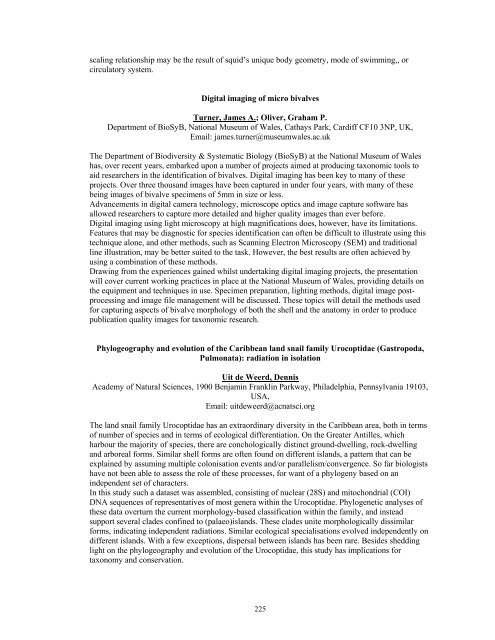World Congress of Malacology Antwerp ... - Unitas Malacologica
World Congress of Malacology Antwerp ... - Unitas Malacologica
World Congress of Malacology Antwerp ... - Unitas Malacologica
You also want an ePaper? Increase the reach of your titles
YUMPU automatically turns print PDFs into web optimized ePapers that Google loves.
scaling relationship may be the result <strong>of</strong> squid’s unique body geometry, mode <strong>of</strong> swimming,, or<br />
circulatory system.<br />
Digital imaging <strong>of</strong> micro bivalves<br />
Turner, James A.; Oliver, Graham P.<br />
Department <strong>of</strong> BioSyB, National Museum <strong>of</strong> Wales, Cathays Park, Cardiff CF10 3NP, UK,<br />
Email: james.turner@museumwales.ac.uk<br />
The Department <strong>of</strong> Biodiversity & Systematic Biology (BioSyB) at the National Museum <strong>of</strong> Wales<br />
has, over recent years, embarked upon a number <strong>of</strong> projects aimed at producing taxonomic tools to<br />
aid researchers in the identification <strong>of</strong> bivalves. Digital imaging has been key to many <strong>of</strong> these<br />
projects. Over three thousand images have been captured in under four years, with many <strong>of</strong> these<br />
being images <strong>of</strong> bivalve specimens <strong>of</strong> 5mm in size or less.<br />
Advancements in digital camera technology, microscope optics and image capture s<strong>of</strong>tware has<br />
allowed researchers to capture more detailed and higher quality images than ever before.<br />
Digital imaging using light microscopy at high magnifications does, however, have its limitations.<br />
Features that may be diagnostic for species identification can <strong>of</strong>ten be difficult to illustrate using this<br />
technique alone, and other methods, such as Scanning Electron Microscopy (SEM) and traditional<br />
line illustration, may be better suited to the task. However, the best results are <strong>of</strong>ten achieved by<br />
using a combination <strong>of</strong> these methods.<br />
Drawing from the experiences gained whilst undertaking digital imaging projects, the presentation<br />
will cover current working practices in place at the National Museum <strong>of</strong> Wales, providing details on<br />
the equipment and techniques in use. Specimen preparation, lighting methods, digital image postprocessing<br />
and image file management will be discussed. These topics will detail the methods used<br />
for capturing aspects <strong>of</strong> bivalve morphology <strong>of</strong> both the shell and the anatomy in order to produce<br />
publication quality images for taxonomic research.<br />
Phylogeography and evolution <strong>of</strong> the Caribbean land snail family Urocoptidae (Gastropoda,<br />
Pulmonata): radiation in isolation<br />
Uit de Weerd, Dennis<br />
Academy <strong>of</strong> Natural Sciences, 1900 Benjamin Franklin Parkway, Philadelphia, Pennsylvania 19103,<br />
USA,<br />
Email: uitdeweerd@acnatsci.org<br />
The land snail family Urocoptidae has an extraordinary diversity in the Caribbean area, both in terms<br />
<strong>of</strong> number <strong>of</strong> species and in terms <strong>of</strong> ecological differentiation. On the Greater Antilles, which<br />
harbour the majority <strong>of</strong> species, there are conchologically distinct ground-dwelling, rock-dwelling<br />
and arboreal forms. Similar shell forms are <strong>of</strong>ten found on different islands, a pattern that can be<br />
explained by assuming multiple colonisation events and/or parallelism/convergence. So far biologists<br />
have not been able to assess the role <strong>of</strong> these processes, for want <strong>of</strong> a phylogeny based on an<br />
independent set <strong>of</strong> characters.<br />
In this study such a dataset was assembled, consisting <strong>of</strong> nuclear (28S) and mitochondrial (COI)<br />
DNA sequences <strong>of</strong> representatives <strong>of</strong> most genera within the Urocoptidae. Phylogenetic analyses <strong>of</strong><br />
these data overturn the current morphology-based classification within the family, and instead<br />
support several clades confined to (palaeo)islands. These clades unite morphologically dissimilar<br />
forms, indicating independent radiations. Similar ecological specialisations evolved independently on<br />
different islands. With a few exceptions, dispersal between islands has been rare. Besides shedding<br />
light on the phylogeography and evolution <strong>of</strong> the Urocoptidae, this study has implications for<br />
taxonomy and conservation.<br />
225



